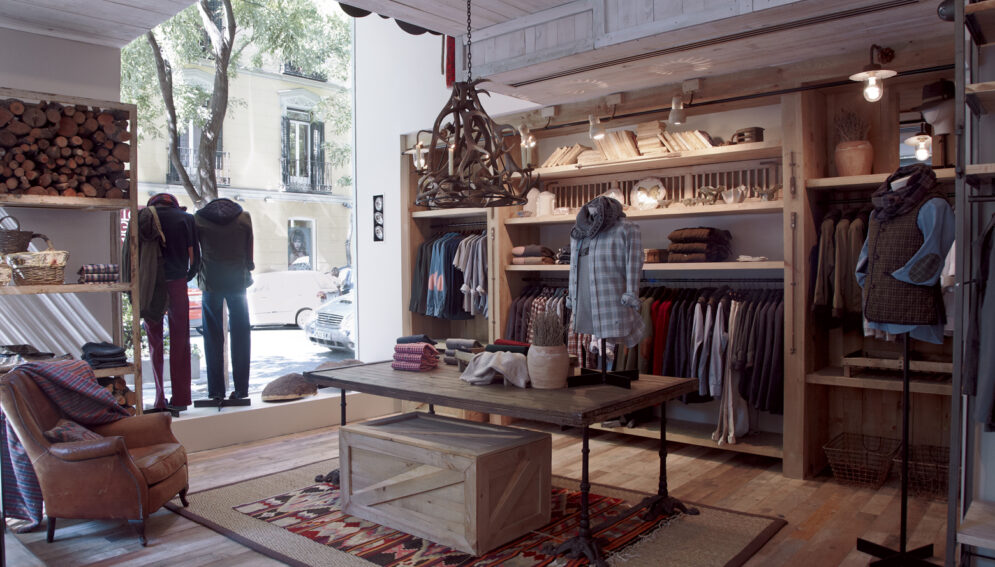On September 20, Victorio & Lucchino (V&L) established its first shop for men in nr. 28, Lagasca Street in Madrid. The inauguration made a splash in the media and in the public. The Spanish real-life magazine Hola.com made the event its main story: “Victorio and Lucchino open a store for the XXIst century man”. The reason is simple: it profoundly reshapes the shopping experience, in such a way that from now on, plenty of men shall feel relieved when outfitting for the coming season.
The essence of the Victorio & Lucchino brand
In the late 70s, José Victor Rodríguez and José Luis Medina joined efforts to create a brand, which has become over time one of the most representative and high-profile in the Spanish fashion industry.
When designing garments, they become inspired first by their homeland roots, which they then deconstruct and project into the future. They do so with a style that identifies them: aspirational, determined, seeking both perfection and good taste. Lastly, they add “a wink”.
What their garments’ label used to claim isn’t pure coincidence: “40% love, 25% charm, 35% joy”. V&L soon became a leading brand among women.
However, after reaching a strategic agreement with the company Manufacturas Andreu in 2010, V&L took on the challenge of selling directly to men. For over a decade, this partner had been supplying V&L its line of fashion accessories.
Together with the key executives of the firm, Andreu and Xavier Aspa, we started devising the new retail formula by the end of the year.
Inspired by men
The company is clearly customer-centric. From the very beginning of the project it was crystal clear that the retail innovation should be grounded in the understanding of the -not very passionate- relationship between most men and fashion.
The insights gathered in qualitative market studies indicated that in general, the male population regarded clothes shopping for a particular context (professional or leisure) an unwelcome chore, namely because it requires, at least, three kinds of efforts: it is time-consuming, coordinating clothes is challenging and, finally, trying them on is a hassle.
Therefore, the V&L concept was thought up to provide a greater life quality to those men who value a classy look according to their personal taste, and with a little mischief.
The playing field
At the time the project was being conceived, we saw that the fashion retail sector was undergoing radical changes, particularly in three areas:
- Consumers have increased their expectations regarding product, services, price and environmental impact.
- At an economic level, there’s economic instability, demand has decreased and margins are dwindling.
- Digital technologies are becoming ever more available, thus allowing for new online purchasing habits.
More and better of the usual methods are no longer enough: new, innovative retail business models are called for. This is not meant to be trivial, but an entrepreneurial must.
The team was absolutely determined about one thing: we shouldn’t only create a shop, but a new retail formula, devised in such a way that it would attract customers back again and again. For this purpose, it was necessary to ground the purchase experience in these two axis:
- The shop should reflect the values of the V&L brand, its creativity and magic. The setting would be essential.
- The shopping experience should be empathic, smooth and customised. New and powerful technologies were called for, subtly inserted in the shopping process, heavily supported by the back-end and leveraging on cloud computing.
The setting and its technologies
The shop has 150 m2 distributed in two floors, with a very high ceiling.
The ground floor represents a spacious living room, expressed with the particular imagination, style and liveliness of the two Sevillian designers. The products are displayed therein, separated by user context. There is an area dedicated to formal wear for work, another one for casual moments, and a third with a rather more country touch.
The shop maximises customer convenience by tailoring their shopping experience and reducing their efforts in a fun way, namely through two steps: the Pinpoint and the Canvas.
The Pinpoint experience
New customers are invited to enjoy the service of diagnosing their aesthetic preferences in the PinPoint area, a little study which reproduces the designers’ atelier.
There, customers can find out -with the help of a tablet and a stylist- what style matches their personal taste best for every context (work and leisure). Later, their body measurements are taken.
All this information is stored in the cloud for when it may be needed again. This way, return visits will take significantly less time (it won’t be necessary to start from scratch) and shall even be more accurate (the computing system knows the customer’s taste and updates it with every new purchase).
The Canvas revelation
Once the profile has been outlined in the PinPoint section, the customer is ushered to the Canvas, a 40’’ multi-touch table-tablet standing in an iconic space within the shop. There, and guided by the sales assistant, the machine proposes three outfits, taking into account the personal preferences and what they are needed for. The customer himself can also handle the oversized tablet in order to adjust the results.
The program can also recommend other combinations on the basis of a given garment the user might have selected, as it is capable of recognising every item in the shop by just placing it on the screen. A complex system of algorithms matches customer taste with garment tags.
The Canvas reduces the risk of a poor choice and the customer rests assured that the items he buys match, that they suit his style and all this without trying on many things.
This is a good example of how technologies shouldn’t be used for their own sake, but rather as a means to an efforts-free shopping experience for customers.
Two years, one orchestra
During the two years in which the project was developed, Andreu and Xavier hired outstanding professionals, each one an expert in their own discipline. Martínez + Franch (m+f=!) were entrusted with the retail innovation consultancy, while the conceptualisation of the interior was developed by both designers of the brand and the architecture firm “Madrid in Love”. The technology was built to order by Raona based on the Pixel Sense structure, a combination of Samsung and Microsoft products. Another key asset has been the fashion designer Gala Canut, responsible for the collection and style.
In addition, the company paid special attention when selecting the sales team, according to their human empathy and aesthetic sensitivity. Their training took long and was meticulous.
Andreu and Xavier haven’t only conducted the orchestra, but they have taken special care of every detail and played as many tunes as necessary to accomplish their results.
The shop will be considered a pilot for one year. In other words, it will be a space to learn until it can be confirmed it works with high profitability and customer satisfaction. In the next stage, the chain shall expand in Spain and internationally.
More than just a shop
Victorio & Lucchino Men is a fascinating store and a fully innovative retail ecosystem, created to yield sustained cash flow. It is a complete business model (front-end plus back-end) that expresses the V&L brand with the five senses. It is based in customer centricity with a single purpose: sustained loyalty. That is why we have added the prefix -eco to the word system.
_______________
Lluis Martinez-Ribes
Source: Código 84
special edition for Aecoc Congress
October 2012




